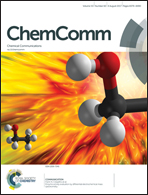A comparative study of magnetization dynamics in dinuclear dysprosium complexes featuring bridging chloride or trifluoromethanesulfonate ligands†
Abstract
We utilized a rigid ligand platform PyCp22− (PyCp22− = [2,6-(CH2C5H3)2C5H3N]2−) to isolate dinuclear Dy3+ complexes [(PyCp2)Dy-(μ-O2SOCF3)]2 (1) and [(PyCp2)Dy-(μ-Cl)]2 (3) as well as the mononuclear complex (PyCp2)Dy(OSO2CF3)(thf) (2). Compounds 1 and 2 are the first examples of organometallic Dy3+ complexes featuring triflate binding. The isolation of compounds 1 and 3 allows us to comparatively evaluate the effects of the bridging anions on the magnetization dynamics of the dinuclear systems. Our investigations show that although the exchange coupling interactions differ for 1 and 3, the dynamic magnetic properties are dominated by relaxation via the first excited state Kramers doublet of the individual Dy sites. Compounds 1 and 3 exhibit barriers to magnetization reversal (Ueff = 49 cm−1) that can be favorably compared to those of the previously reported examples of [Cp2Dy(μ-Cl)]2 (Ueff = 26 cm−1) and [Cp2Dy(thf)(μ-Cl)]2 (Ueff = 34 cm−1).

- This article is part of the themed collection: 2017 Emerging Investigators


 Please wait while we load your content...
Please wait while we load your content...